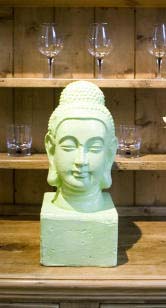

HoustonChronicle.com -- http://www.HoustonChronicle.com | Section: Home & Garden
Aug. 18, 2006, 8:25PM

To get inside the head of interior designer Keith Dalhover, consider another head
displayed dramatically in the living-dining area of his Montrose condo. Dalhover found a 20-inch Tibetan-style Buddha figure at TJ Maxx for a cool $15. He painted it a delicious wasabi green — he almost went with deep pink — and set it between glass candelabras on a pine china cabinet.
It doesn't matter to Dalhover that the cabinet, made of wood reclaimed from the Thames River, is "almost British Colonial." Or that three Charles and Ray Eames-designed chairs nearby — including a new version of the classic 1956 lounge chair — speak to a different era on the other side of the Atlantic. Or that the price tags on some of these pieces were, shall we say, significantly steeper than the discount Buddha.
"The elements are just scale and proportion," he says. "You can mix anything as long as the scale works. And if scale is done right, it can create drama."
Dalhover Design is about six years old. But Bill Stubbs, a Houston-based international interior designer who has been in the business for decades, echoes Dalhover's sentiments.
"Effective design is when you don't have any rules," says Stubbs, who is currently designing the interior of an Airbus 319 plane in Basel, Switzerland.
"In my mother's day, an entire room might be done in an Asian theme. But in the past 20 to 30 years, we've gotten away from even understanding what that means."
Combining high and low-end furnishings and accessories is perfectly acceptable, says Stubbs, so long as the scale and proportions work. "I love the idea of a River Oaks house with Southeby's and Christie's pieces and a piece from TJ Maxx," he says. "It's nice to relax and have fun with design."
Dalhover has the high-low concept working throughout his space. Among the items sitting on a marble table top he snagged for free from a London pub is an exquisite, hand-painted papier-mâché Russian lacquer box.
Dalhover, who's been known to rearrange his furniture and accessories weekly, painted the walls of his living-dining room gray. This gives him a tabula rasa for furnishings that dip into different centuries and countries, including Japan, Russia, Asia, England and the U.S.
A long wall holds Japanese prints from original woodblocks of artist Utagawa Hiroshige, from the series One Hundred Famous Views of Edo. "With the walls being muted," says Dalhover, "the colors in the prints just pop of the wall."
To warm up the two-tone dining area area, "soften" the table's glass and cast iron and suggest an "English manor feel," Dalhover hung a rich pine mirror with a traditional rope-patterned frame on the wall there. Above the living area's sofa, a thick slice of a bird's-eye-maple stump, smoothed and shaped by artist Rex Burningham, provides an organic antidote to the leather and glass below.
In a corner, Dalhover groups his art glass on industrial metal shelves and lights them from below. The glass and chrome of a Florence Knoll coffee table also help create an illusion of space, tucked between the chairs and a basic black sofa.
"In a smaller room, you want to be able to see through things and under things," Dalhover says. "Tables with thin legs or glass tops take up surface space but leave the eye plane open. And it keeps things visually light."
Although the room measures only 14 by 20 feet, the artful arrangement allows for a space that seats up to 10 people comfortably.
"It's a small room," says Dalhover, "but every time someone walks in, they say, 'I can't believe you got this much stuff in here!' " [end]